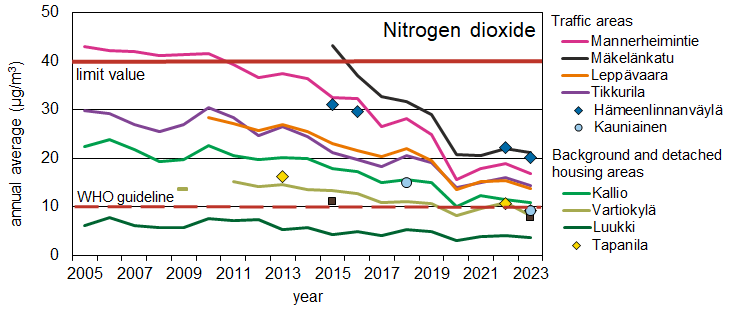Adverse effects on air quality caused by traffic exhaust gases are declining – street dust and wood burning continue to be challenges in the Helsinki metropolitan area

According to HSY’s monitoring, the adverse effects on air quality caused by traffic exhaust gases have decreased. Exhaust gas concentrations dropped slightly at the monitoring sites in the Helsinki metropolitan area in 2023 compared to the previous year. The air quality still becomes poor at times due to street dust and emissions from wood burning.
Renewal of the car fleet means reduced exhaust gases
The Helsinki Region Environmental Services Authority HSY monitors air quality in different types of environments throughout the Helsinki metropolitan area. The monitoring suggests that the concentrations of nitrogen dioxide from exhaust gases decreased in 2023.
“Exhaust gas concentrations declined last year at all of our air quality monitoring sites. The renewal and electrification of the car fleet will further reduce the concentrations of nitrogen dioxide in the future”, says Saija Korhonen, Expert in Air Quality at HSY.
According to HSY’s monitoring, the EU annual limit value for nitrogen dioxide has not been exceeded at any of the air quality monitoring sites in recent years. On the other hand, the stricter annual guideline value of the World Health Organization (WHO) for nitrogen dioxide is exceeded at almost all of the monitoring sites.
Street dust poses challenges along both streets and roads
Thoracic particles, i.e. street dust, reduce the air quality in the Helsinki metropolitan area especially on dry spring days. Last year, the limit value level for thoracic particles was exceeded in traffic environments at several HSY monitoring sites. The limit value level may be exceeded on no more than 35 days per year. The highest number of days exceeding the limit value level was along Hämeenlinnanväylä with 29 days. There were 27 of such dusty days on Mäkelänkatu in central Helsinki.
“Although street dust concentrations in the air were at their highest in the spring, there were several dusty days along busy streets and roads after the start of the winter tyre season in the autumn. Studded tyres wear down the asphalt surface and produce clearly higher amounts of street dust than friction tyres”, Korhonen says.
The EU 24-hour limit value for thoracic particles has not been exceeded anywhere in recent years. On the other hand, the stricter 24-hour guideline of the World Health Organization (WHO) is exceeded in all high-traffic areas.
Wood burning reduces the air quality in detached housing areas
Burning wood generates, among other things, fine particles that are harmful to health as well as black carbon, i.e. soot. However, good wood burning practices can significantly reduce the emissions from wood burning.
“Last year, we measured increased concentrations of fine particles and black carbon in detached housing areas especially in the evenings. On some windless and freezing nights, the concentrations rose to be higher than in high-traffic areas during rush hour”, Korhonen says.
Burning wood also produces PAH compounds, such as benzo(a)pyrene, that increase the risk of cancer. Benzo(a)pyrene concentrations both at and below the target value were measured in detached housing areas. The concentrations vary widely between and within detached housing areas, and they are also greatly impacted by weather conditions.
HSY will publish the Air Quality in the Helsinki Metropolitan Area in 2023 report in June 2024. Air quality in the Helsinki metropolitan area and elsewhere in Uusimaa can be monitored in real time at hsy.fi/en/airquality.

FIGURE. Annual concentrations of nitrogen dioxide at different air quality monitoring sites from 2005 to 2023. The concentrations have fallen below the EU annual limit value, but the WHO annual guideline value is exceeded at almost all monitoring sites.
Information on air pollutants
- Nitrogen oxides in the breathing air originate from traffic emissions, especially from diesel cars and heavy vehicles. Of the nitrogen oxides, nitrogen dioxide is the most harmful to health. It contracts the bronchi in high concentrations and increases respiratory symptoms, especially in children and asthmatics.
- Thoracic particles are mostly street dust suspended by traffic, which can be harmful to health. Elevated concentrations of street dust reduce the well-being of people with respiratory conditions, in particular.
- Black carbon, i.e. soot, is released into the air as a result of incomplete combustion. The main emission sources in the Helsinki metropolitan area include direct exhaust emissions, burning wood in fireplaces, ship traffic and long-range transport. There are organic compounds harmful to health, such as PAHs, other organic compounds and metals attached to the surfaces of the soot particles released into the air during combustion.
- Fine particles are mainly generated from traffic and wood burning emissions. In addition, they are transported to the Helsinki metropolitan area from outside the country’s borders. Fine particles are considered particularly harmful to health, as they are able to penetrate into even the peripheral areas of the lungs. The groups most sensitive to the health effects of air pollutants are small children, elderly people, and those with respiratory and heart conditions.
- PAH compounds, including benzo(a)pyrene, are created through incomplete combustion. Elevated concentrations of benzo(a)pyrene occur especially in residential areas with a lot of wood heating for individual houses. The effect of traffic emissions on PAH concentrations is minor. Benzo(a)pyrene and many other PAHs increase the risk of cancer.
Further information:
Health effects of air pollutants - HSY